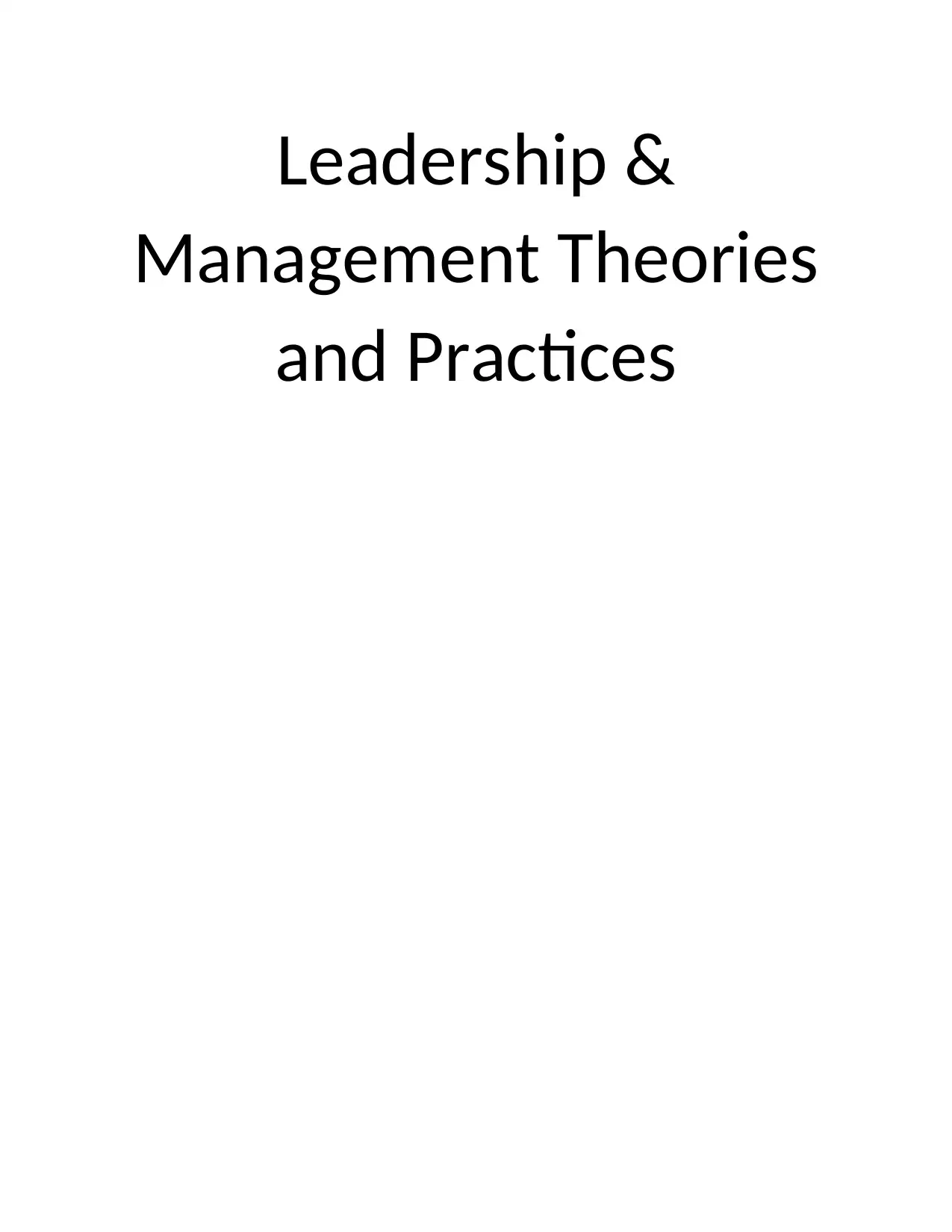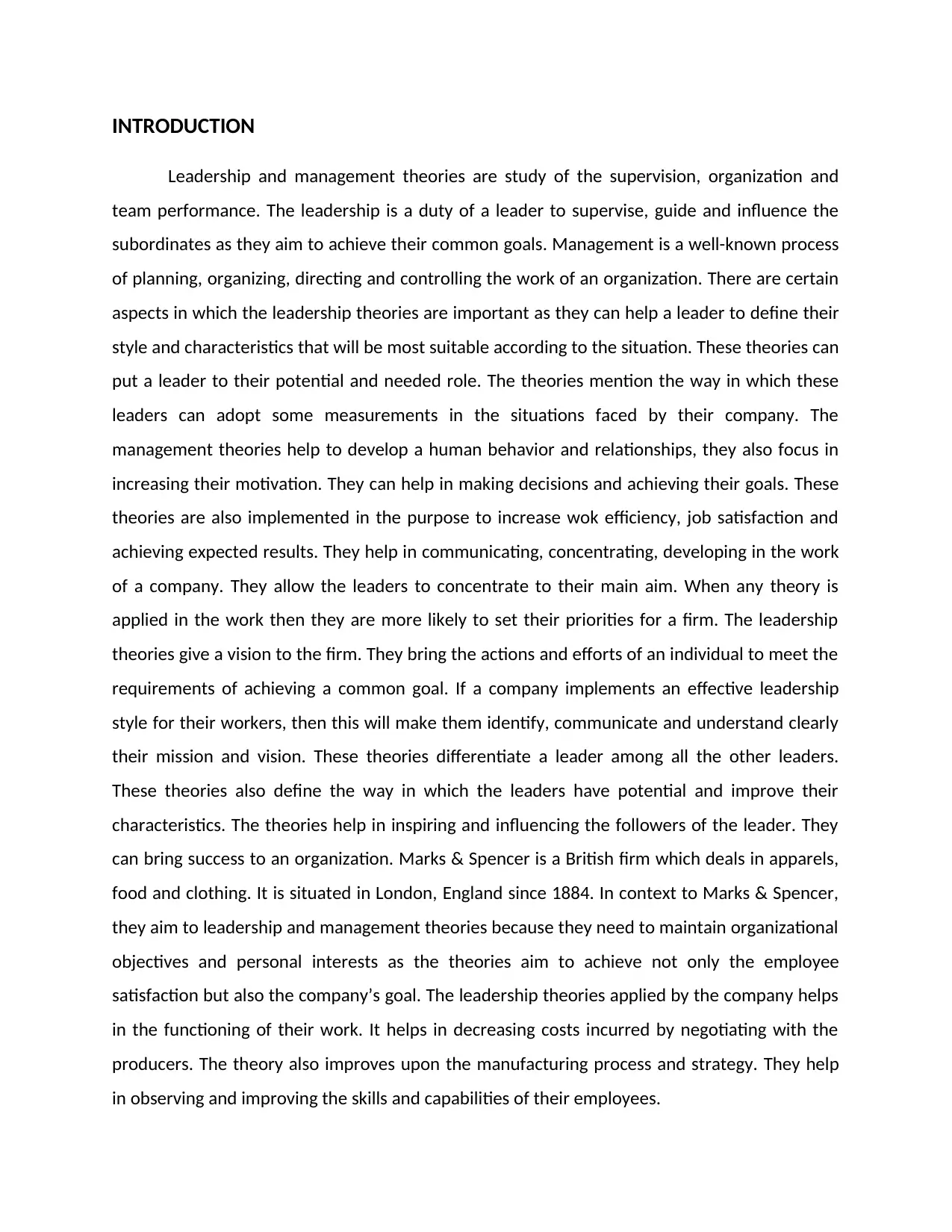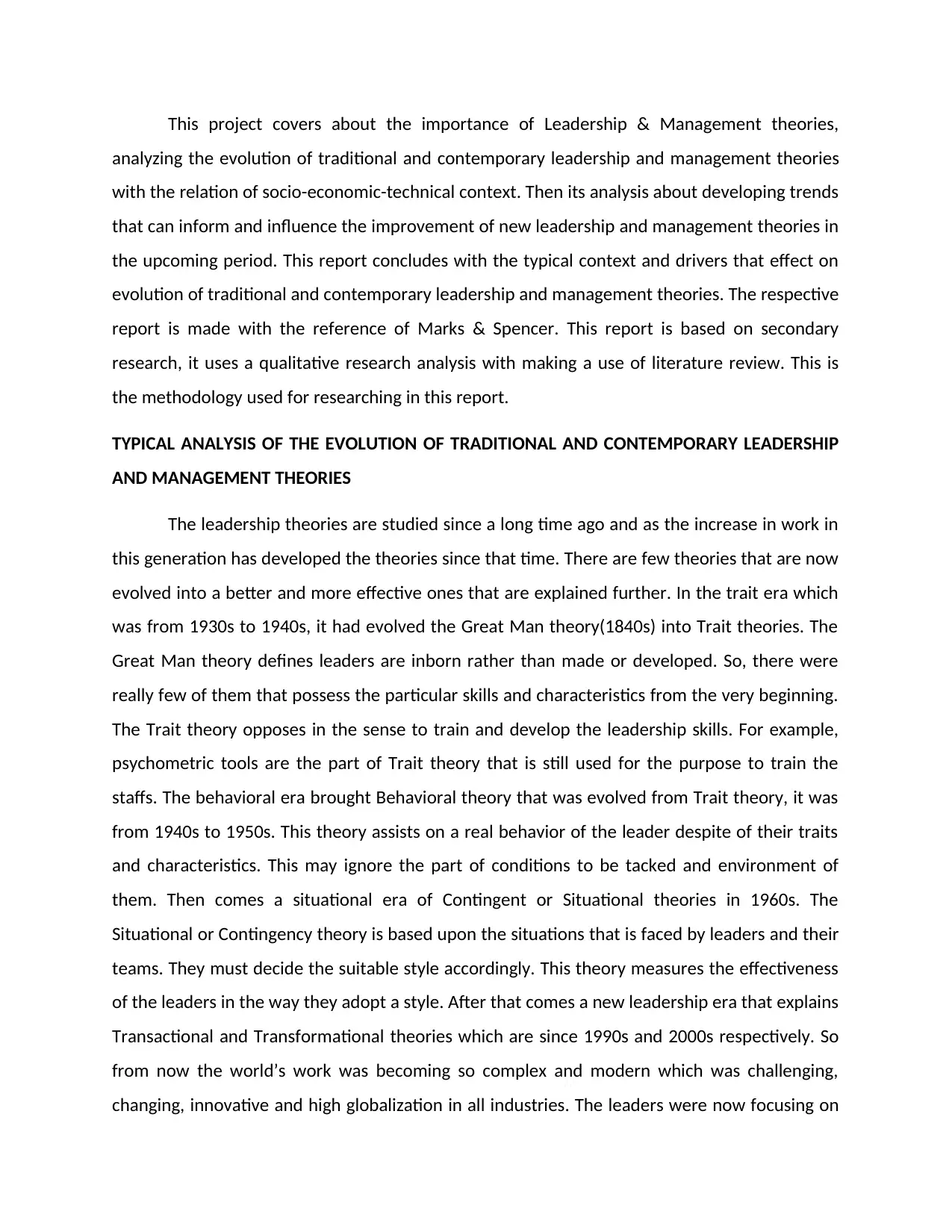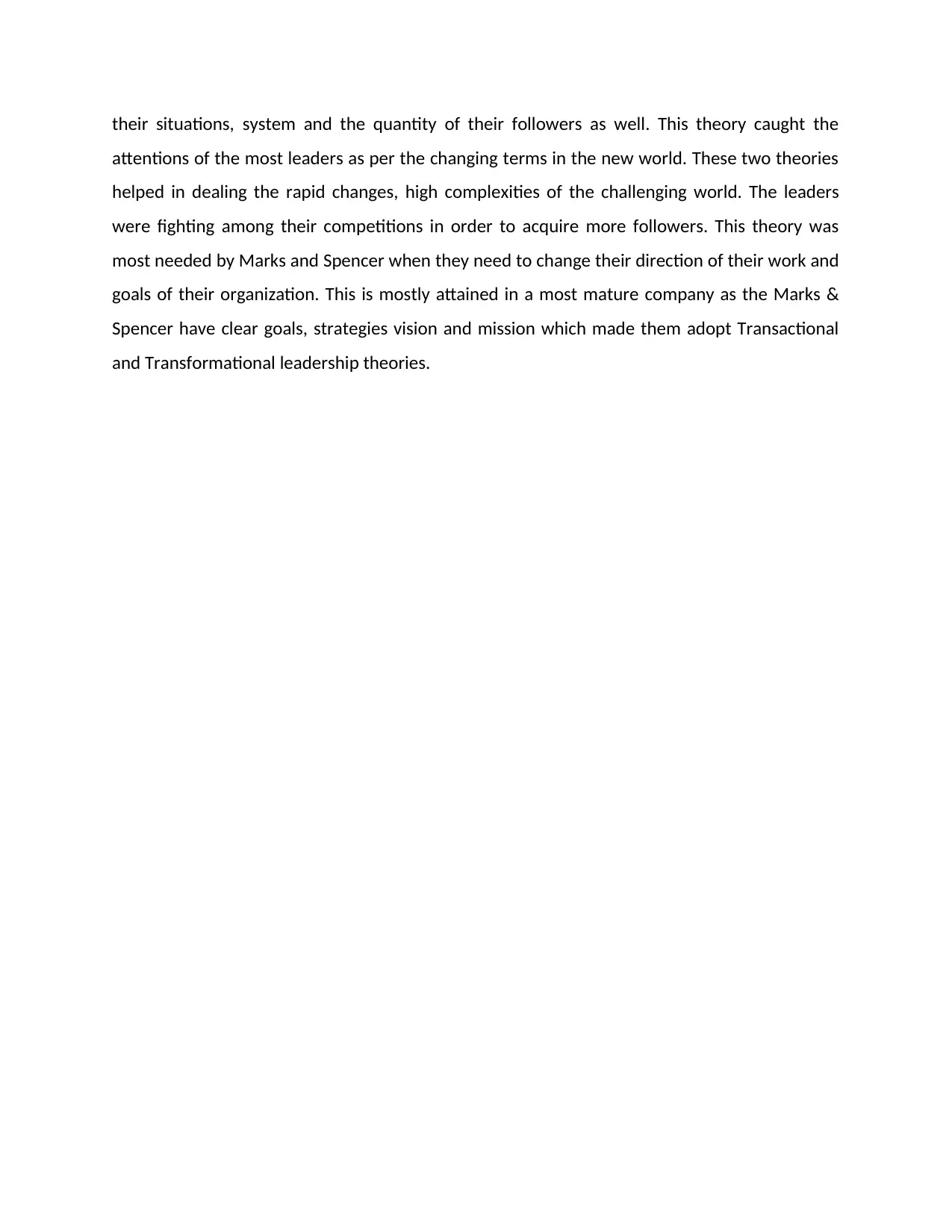Leadership & Management Theories and Practices: M&S Case Analysis
VerifiedAdded on 2023/06/12
|4
|1020
|243
Essay
AI Summary
This essay provides an analysis of leadership and management theories and practices, focusing on the evolution of traditional and contemporary theories within a socio-economic-technical context, using Marks & Spencer as a case study. It explores the importance of these theories in maintaining organizational objectives and employee satisfaction. The essay examines the shift from the Great Man theory to Trait, Behavioral, Situational, Transactional, and Transformational theories, highlighting their impact on organizational leadership. The research methodology is based on secondary research and qualitative analysis, using literature review to understand the drivers and contexts affecting the evolution of these theories, particularly within Marks & Spencer, emphasizing the company's adoption of Transactional and Transformational leadership theories due to its clear goals, strategies, vision, and mission.

Leadership &
Management Theories
and Practices
Management Theories
and Practices
Paraphrase This Document
Need a fresh take? Get an instant paraphrase of this document with our AI Paraphraser

INTRODUCTION
Leadership and management theories are study of the supervision, organization and
team performance. The leadership is a duty of a leader to supervise, guide and influence the
subordinates as they aim to achieve their common goals. Management is a well-known process
of planning, organizing, directing and controlling the work of an organization. There are certain
aspects in which the leadership theories are important as they can help a leader to define their
style and characteristics that will be most suitable according to the situation. These theories can
put a leader to their potential and needed role. The theories mention the way in which these
leaders can adopt some measurements in the situations faced by their company. The
management theories help to develop a human behavior and relationships, they also focus in
increasing their motivation. They can help in making decisions and achieving their goals. These
theories are also implemented in the purpose to increase wok efficiency, job satisfaction and
achieving expected results. They help in communicating, concentrating, developing in the work
of a company. They allow the leaders to concentrate to their main aim. When any theory is
applied in the work then they are more likely to set their priorities for a firm. The leadership
theories give a vision to the firm. They bring the actions and efforts of an individual to meet the
requirements of achieving a common goal. If a company implements an effective leadership
style for their workers, then this will make them identify, communicate and understand clearly
their mission and vision. These theories differentiate a leader among all the other leaders.
These theories also define the way in which the leaders have potential and improve their
characteristics. The theories help in inspiring and influencing the followers of the leader. They
can bring success to an organization. Marks & Spencer is a British firm which deals in apparels,
food and clothing. It is situated in London, England since 1884. In context to Marks & Spencer,
they aim to leadership and management theories because they need to maintain organizational
objectives and personal interests as the theories aim to achieve not only the employee
satisfaction but also the company’s goal. The leadership theories applied by the company helps
in the functioning of their work. It helps in decreasing costs incurred by negotiating with the
producers. The theory also improves upon the manufacturing process and strategy. They help
in observing and improving the skills and capabilities of their employees.
Leadership and management theories are study of the supervision, organization and
team performance. The leadership is a duty of a leader to supervise, guide and influence the
subordinates as they aim to achieve their common goals. Management is a well-known process
of planning, organizing, directing and controlling the work of an organization. There are certain
aspects in which the leadership theories are important as they can help a leader to define their
style and characteristics that will be most suitable according to the situation. These theories can
put a leader to their potential and needed role. The theories mention the way in which these
leaders can adopt some measurements in the situations faced by their company. The
management theories help to develop a human behavior and relationships, they also focus in
increasing their motivation. They can help in making decisions and achieving their goals. These
theories are also implemented in the purpose to increase wok efficiency, job satisfaction and
achieving expected results. They help in communicating, concentrating, developing in the work
of a company. They allow the leaders to concentrate to their main aim. When any theory is
applied in the work then they are more likely to set their priorities for a firm. The leadership
theories give a vision to the firm. They bring the actions and efforts of an individual to meet the
requirements of achieving a common goal. If a company implements an effective leadership
style for their workers, then this will make them identify, communicate and understand clearly
their mission and vision. These theories differentiate a leader among all the other leaders.
These theories also define the way in which the leaders have potential and improve their
characteristics. The theories help in inspiring and influencing the followers of the leader. They
can bring success to an organization. Marks & Spencer is a British firm which deals in apparels,
food and clothing. It is situated in London, England since 1884. In context to Marks & Spencer,
they aim to leadership and management theories because they need to maintain organizational
objectives and personal interests as the theories aim to achieve not only the employee
satisfaction but also the company’s goal. The leadership theories applied by the company helps
in the functioning of their work. It helps in decreasing costs incurred by negotiating with the
producers. The theory also improves upon the manufacturing process and strategy. They help
in observing and improving the skills and capabilities of their employees.

This project covers about the importance of Leadership & Management theories,
analyzing the evolution of traditional and contemporary leadership and management theories
with the relation of socio-economic-technical context. Then its analysis about developing trends
that can inform and influence the improvement of new leadership and management theories in
the upcoming period. This report concludes with the typical context and drivers that effect on
evolution of traditional and contemporary leadership and management theories. The respective
report is made with the reference of Marks & Spencer. This report is based on secondary
research, it uses a qualitative research analysis with making a use of literature review. This is
the methodology used for researching in this report.
TYPICAL ANALYSIS OF THE EVOLUTION OF TRADITIONAL AND CONTEMPORARY LEADERSHIP
AND MANAGEMENT THEORIES
The leadership theories are studied since a long time ago and as the increase in work in
this generation has developed the theories since that time. There are few theories that are now
evolved into a better and more effective ones that are explained further. In the trait era which
was from 1930s to 1940s, it had evolved the Great Man theory(1840s) into Trait theories. The
Great Man theory defines leaders are inborn rather than made or developed. So, there were
really few of them that possess the particular skills and characteristics from the very beginning.
The Trait theory opposes in the sense to train and develop the leadership skills. For example,
psychometric tools are the part of Trait theory that is still used for the purpose to train the
staffs. The behavioral era brought Behavioral theory that was evolved from Trait theory, it was
from 1940s to 1950s. This theory assists on a real behavior of the leader despite of their traits
and characteristics. This may ignore the part of conditions to be tacked and environment of
them. Then comes a situational era of Contingent or Situational theories in 1960s. The
Situational or Contingency theory is based upon the situations that is faced by leaders and their
teams. They must decide the suitable style accordingly. This theory measures the effectiveness
of the leaders in the way they adopt a style. After that comes a new leadership era that explains
Transactional and Transformational theories which are since 1990s and 2000s respectively. So
from now the world’s work was becoming so complex and modern which was challenging,
changing, innovative and high globalization in all industries. The leaders were now focusing on
analyzing the evolution of traditional and contemporary leadership and management theories
with the relation of socio-economic-technical context. Then its analysis about developing trends
that can inform and influence the improvement of new leadership and management theories in
the upcoming period. This report concludes with the typical context and drivers that effect on
evolution of traditional and contemporary leadership and management theories. The respective
report is made with the reference of Marks & Spencer. This report is based on secondary
research, it uses a qualitative research analysis with making a use of literature review. This is
the methodology used for researching in this report.
TYPICAL ANALYSIS OF THE EVOLUTION OF TRADITIONAL AND CONTEMPORARY LEADERSHIP
AND MANAGEMENT THEORIES
The leadership theories are studied since a long time ago and as the increase in work in
this generation has developed the theories since that time. There are few theories that are now
evolved into a better and more effective ones that are explained further. In the trait era which
was from 1930s to 1940s, it had evolved the Great Man theory(1840s) into Trait theories. The
Great Man theory defines leaders are inborn rather than made or developed. So, there were
really few of them that possess the particular skills and characteristics from the very beginning.
The Trait theory opposes in the sense to train and develop the leadership skills. For example,
psychometric tools are the part of Trait theory that is still used for the purpose to train the
staffs. The behavioral era brought Behavioral theory that was evolved from Trait theory, it was
from 1940s to 1950s. This theory assists on a real behavior of the leader despite of their traits
and characteristics. This may ignore the part of conditions to be tacked and environment of
them. Then comes a situational era of Contingent or Situational theories in 1960s. The
Situational or Contingency theory is based upon the situations that is faced by leaders and their
teams. They must decide the suitable style accordingly. This theory measures the effectiveness
of the leaders in the way they adopt a style. After that comes a new leadership era that explains
Transactional and Transformational theories which are since 1990s and 2000s respectively. So
from now the world’s work was becoming so complex and modern which was challenging,
changing, innovative and high globalization in all industries. The leaders were now focusing on
⊘ This is a preview!⊘
Do you want full access?
Subscribe today to unlock all pages.

Trusted by 1+ million students worldwide

their situations, system and the quantity of their followers as well. This theory caught the
attentions of the most leaders as per the changing terms in the new world. These two theories
helped in dealing the rapid changes, high complexities of the challenging world. The leaders
were fighting among their competitions in order to acquire more followers. This theory was
most needed by Marks and Spencer when they need to change their direction of their work and
goals of their organization. This is mostly attained in a most mature company as the Marks &
Spencer have clear goals, strategies vision and mission which made them adopt Transactional
and Transformational leadership theories.
attentions of the most leaders as per the changing terms in the new world. These two theories
helped in dealing the rapid changes, high complexities of the challenging world. The leaders
were fighting among their competitions in order to acquire more followers. This theory was
most needed by Marks and Spencer when they need to change their direction of their work and
goals of their organization. This is mostly attained in a most mature company as the Marks &
Spencer have clear goals, strategies vision and mission which made them adopt Transactional
and Transformational leadership theories.
1 out of 4
Related Documents
Your All-in-One AI-Powered Toolkit for Academic Success.
+13062052269
info@desklib.com
Available 24*7 on WhatsApp / Email
![[object Object]](/_next/static/media/star-bottom.7253800d.svg)
Unlock your academic potential
Copyright © 2020–2025 A2Z Services. All Rights Reserved. Developed and managed by ZUCOL.




